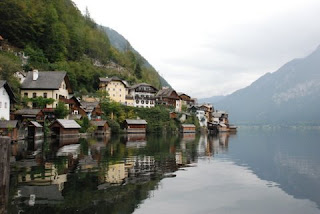



We made a deal yesterday – if it was fine in the morning we would walk up to the salt mine, if it was raining we would use the funicular. It was actually overcast with the cloud base below the mountain peaks and it had rained a little but when we were ready to set off, it wasn't actually raining. We decided to walk. It is quite a long steep walk, zig-zagging up the hillside to to the Hallstatt High Valley but there were frequent information boards with English text and this gave a good excuse to have a breather. There was also a view of the waterfall on the 'Millbrook' that drains the High Valley where thick alluvial clay means that the water does not soak away but runs off very quickly, causing problems in very wet weather. The town of Hallstatt is on a small promontory and this was formed by scree and clay washed down from the mountain.
We reached the top and admired the view from the top before going on to look at the other sights. As we had recently visited a salt mine near Krakow, we did not want to visit this salt mine even though it looked very good – two large wooden slides (great fun – I went down one years ago in the Bad Ischl salt mine), prehistoric shafts, salt lakes etc. We did however visit the Hallstatt Period sites - reconstructed bacon curing pit, the reconstructed miner's house and the famous cemetery. The archaeologists still excavate both the mines and the cemetery every Summer and were there today. They had excavated some prehistoric wood and had it under water sprays outside their offices. They had also been excavating in the huge cemetery – over 1,500 graves had been excavated by 2007 but it is thought that there may be a total of 5,000, enough to keep the archaeologists going for many years! There was a small building that housed an example of two burials, an inhumation and a cremation, complete with examples of the grave goods. It was very well presented but, for some reason best known to the creators, they were playing jolly piped music – perhaps to counteract the solemnity of the burials?
Last year they constructed a steel bridge across the valley that provided access to the funicular and the Rudolf Tower and gave superb views over the lake and the surrounding mountains. We walked over to the tower, admiring the views on the way and found a table by a window in the restaurant on the first floor of the tower. We enjoyed Gulash Soup and the view from the window.
We had hoped to continue our walk down on another path back to the town but found it closed for safety reasons. This meant that we had to retrace our steps down the zig-zag path, then turning left and descending to the opposite side of the town. Here we came to the Parish Catholic Church built in the 16th century with a particularly interesting Charnel House. Since the middle of the 19th century, the local population have removed the bones of their dean from their graves and painted the skulls, sometimes with decorations but always with the name of the deceased. We were able to visit the charnel house and see the exhibit of the skulls, the latest of which was painted in 1995. A strange idea but somehow more seemly than the bone constructions that we had seen in Portugal.
We wandered back through the town to the campsite, pausing to look through glass panels at the remains of the Roman baths under a souvenir shop. Yes, the Romans were here and, of course, exploited the salt deposits but they lived by the side of the lake rather than in the high valley.
Photos: Hallstatt from above; The view from the Hallstatt High Valley with the Rudolf Tower on the left; Looking up the Hallstatt High Valley with the salt mine ahead and the cemetery on the left; Hallstatt and the lake.
No comments:
Post a Comment